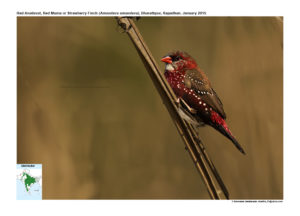Red Avadavat

Red Avadavat Amandava amandava
Etymology:
- Amandava : Derived from Ahemdabad in Gujarat ,India from where these birds were exported for pet trade
- Amandava : Derived from Ahemdabad in Gujarat ,India from where these birds were exported for pet trade
Vernacular Name: Hindi: Laal munia, Guj: Surakh, Laal muniya , Laal tapu shiyu, Mar: Laal manoli, Pun: Laal munia, Surkhan, Te: Torra-jinuwayi, Yerra jinuwayi, Mal: Chuvanna moonia, Kan: Kempu munia
Red Avadavat is a small passerine bird. They are also called Strawberry Finch for the male’s appearance in Breeding Plumage. It was widely sold as a pet caged bird for its beautiful colours.
Distribution in India: Widespread Resident in mainland India except for North West and North East
Description: Size of 9·5–10 cm; wt. of 7·2–9·5 g. The male nominate race in breeding is red from head to back and uppertail-coverts, crown and back are tinged brown, upperwing and tail brownish are black. The scapulars, tertials, wing-coverts, rump and uppertail-coverts, flanks and tips of tail feathers have rows of white spots. The lores and line through eye are black, narrow white line below eye. The breast and flanks is red, belly and undertail-coverts are black. The iris is red to brown, eyering is black; bill is red, often with black line on culmen; legs pinkish. Male non-breeding is like female, but with white spots on red uppertail-coverts, larger pale tips on greater coverts, face is grey, underparts buff to buffish brown. The female is greyish brown above, rump and uppertail-coverts are red with few indistinct white spots, small white or pale buff tips on upperwing-coverts and tertials. The lores are black, throat is whitish, breast and belly are pale buffish, often with slight orange tinge. The juvenile resembles female, but lacks red, has brown rump and uppertail-coverts , buff wingbars ,tertials are edged and tipped buff, face is unmarked grey, underparts are grey to buffy white, iris is brown, bill is dark
Habitat: It is found in grassland, low marshy plains, damp grass, reeds, rice fields, sugar-cane fields, tamarisk scrub, wetlands along rivers and canals, and grassy clearings near cultivation and villages. It is found from lowland up to 2100 m.
Food Habits: They are grain/Seed eaters. They are found in Marshy areas with lots of Tall grass and Reeds. They feed on the reed corns and any spilt grains and seeds. It is occasionally known to eat small worms also.
Breeding Habits: They breed Jun–Dec monsoon in North India, Jun–Aug in Assam, Oct–Mar in South India ; Dec–Jan in Thailand and Aug–Jan in Myanmar; in May in West Java and Jun and Dec in Central Java; Jan–Jul in Flores; in Europe where it is introduced, Jul–Oct in Spain and Nov–Dec in Italy. In the courtship display on ground or low branch, male holds a feather or stem in bill, body feathers fluffed, tail fanned, he raises head and bill, bows slowly towards female, twists tail and the bright uppertail-coverts towards her, and sings between bows, sometimes bows slowly to one side, raises head, and bows to other side. Then on ground, hops in semicircle in front of female, facing her, and bows. The male displays also in horizontal posture, crouches, raises and flutters wing on side farther from mate, turns head towards her and gives soft twitter, some females responding sexually to this display. In displays ending in copulation, male pecks female’s nape, she quivers tail. The established pairs copulate with no preliminary display. The nest is a hollow ball of coarse grass, lined with fine materials, with side entrance hole, built above ground or water in thorny bush, grass, reeds or coarse herbs. They lay a clutch of 4–6 eggs. The incubation period is 11–13 days. The begging nestling lowers head, twists it to side, swings head from side to side, and raises wing on side away from parent. The young leave nest in 17–21 days, fed with regurgitated seeds by parents for further 10–14 days.